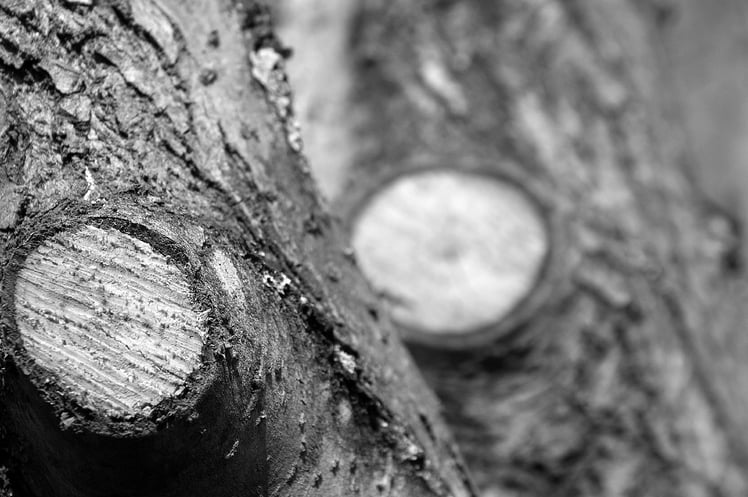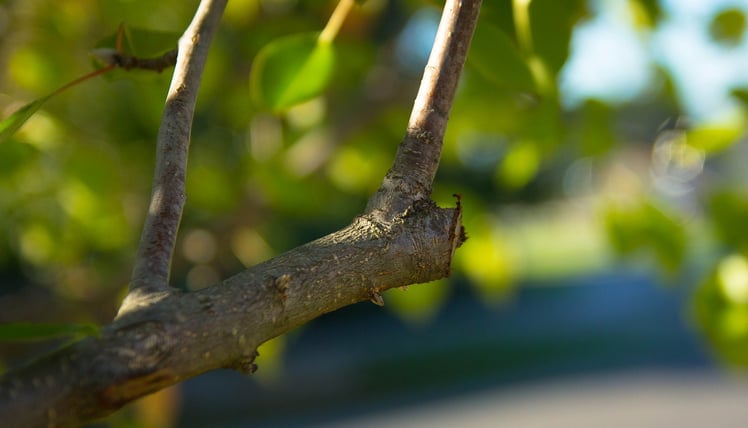It's easy to take trees for granted.
They're always there for us, offering cool shade, bursting out with spectacular fall colors, maybe even offering a crisp apple or a profusion of fluffy pink springtime blooms.
But sometimes they need our help.
Like pruning. But pruning can be tricky. What’s the best time to prune trees in North Carolina? And what about pruning vs trimming?
Misty Gil, client relations manager at Greenscape, Inc., explains it all.
When Is The Best Time to Prune Trees in North Carolina?
“We prune most trees in the late winter,” Gil says. Trees are dormant in winter, which means the fresh pruning cuts will heal faster. Open wounds attract insects and diseases that can harm the tree.
One exception is flowering trees like dogwood and cherry, Gil says. Those are pruned right after they bloom. If you prune them in winter, they won’t bloom the next spring.
“If it blooms before June, we prune right after it blooms,” Gil says. “If it blooms after June, then we prune it in winter.”
Another exception: evergreens. They never become fully dormant, so they’re pruned during the growing season.
OK, One More Exception: Safety
A dead or diseased tree branch could topple at any time, posing a danger to people and property. In that case, it has to go. Now.
“If a tree is posing a safety or hazard concern, we prune it whenever we need to,” Gil says. “We try to stay away from pruning in the hot summer weather, but if safety is involved, no time is the wrong time to prune.”
Related Reading: How To Add Safety, Security And Street Appeal To Your Commercial Property
Why Do Trees Need Pruning?
Lots of reasons.
If tree branches are broken, weak or diseased, they pose a safety hazard.
When branches cross, they rub against each other in the wind, eventually creating open wounds that invite insects and disease.
Tree canopies can grow too low, obscuring sight lines of drivers and pedestrians.
Wayward branches can snag passers-by. Overgrown branches create hiding places for vandals, trespassers and criminals.
Sometime small branches are so shaded from sunlight that they’ll never thrive.
These are all great candidates for pruning.
Even Young Trees Need Pruning
Don’t assume pruning is just for mature trees. Prune a tree properly when it’s young and you set it up for a lifetime of healthy and attractive growth.
“It's best to prune when a tree is small, so you're not cutting big branches off and leaving a big wound that’s harder for the tree to heal,” Gil says.

Give a tree the right structural pruning while it’s young and it will need less corrective pruning as it grows.
Ignore it, and you might end up with an overgrown tree that will need extensive — and expensive — pruning later.
Pruning Vs Trimming
They’re not the same thing.
“Small shrubs and hedges are typically trimmed with gas- powered shears three times a year, and it’s mostly for aesthetics,” Gil says. Trimming takes off any unruly new growth, she says, and tidies everything up.
“Pruning is done once a year with hand-held pruners or loppers,” she says, “and is more for the health and benefit of the tree.”
Tree Pruning, Step By Step
“It takes some critical thinking to really look at a tree and see what needs to stay and what needs to go,” Gil says. So the first step in pruning is close inspection.
“First you walk up to the tree and see what needs to come off,” she says. “Low branches, dead or diseased branches. Any small branches that are so shaded they’ll never get enough sunlight to survive.”
While smaller branches are easily snipped, “if a larger branch needs to come off, more planning needs to take place,” Gil says.
Neatness counts.
“Some thought goes into it,” Gil says. “You don't want to leave a woody stub. You want the tree to be able to heal.
We cut about a quarter inch above a vigorous branch.”
When you prune just above a bud, a new branch will grow from that bud. Experts look for buds that face outward, so the new branch will grow toward the outside of the tree.
Leave It To The Pros
“If you do it wrong, you're setting the tree up for failure,” Gil says. “There are a lot of diseases out there. New ones are cropping up all the time.”
If you’re not an expert, it’s easy to leave large open wounds that invite destructive insects and diseases.
Bonus Benefits To Pruning
Don't worry that those sharp pruning cuts are hurting your trees. Pruning is good for them, in a lot of ways.
Pruning keeps trees healthy, so they stand up to snow, ice and wind storms.
Pruning increases air circulation, which helps keeps diseases at bay.
Trees that are routinely pruned tend to live longer than those that are ignored.
Make Pruning A Priority
Don’t wait for an emergency to consider tree pruning, Gil says.
“Any time there's a safety concern or a tree is touching the building, clients feel it's important to prune,” she says.
But proper pruning along the way can prevent those last-minute pruning needs, she says.
“It can become an emergency in a hurry,” she says. “It's important to watch trees and take care of pruning when they're small.”
Leave The Pruning To Greenscape
At Greenscape, Inc., we’re pruning experts. We know when, why and where to make those pro pruning cuts that will keep your trees happy and healthy.
We’ve been meeting the full-service landscaping needs of commercial and residential customers in the Raleigh, Durham, Chapel Hill and Cary areas for more than 35 years.
We offer landscape management and lawn care, design and build services, irrigation, landscape lighting and more.
Call us at 919-552-7742 or fill out our online form to request a free consultation and learn how we can transform your landscape.
We can't wait to hear from you.


